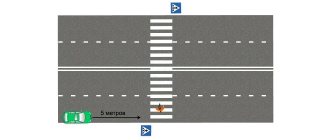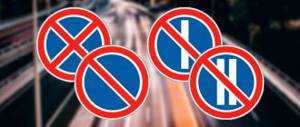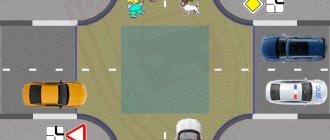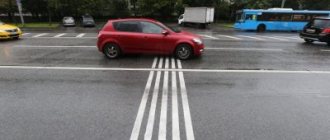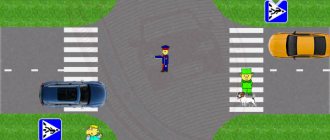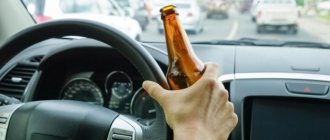The “Pedestrian crossing” sign (5.19) indicates the place on the roadway where people can cross to the other side of the street. Drivers must slow down or stop to let them pass.
Meaning and functions
The sign exists in two versions: on one the person moves to the left (5.19.1), on the other to the right (5.19.2). Usually they are located side by side, on opposite sides of the road, highlighting a designated area for crossing.
Most often there is a zebra between them.
The area intended for pedestrians can be regulated, that is, with a traffic light, or unregulated.
If there is a traffic light nearby (automatic or equipped with buttons), then pedestrians should cross only when the green light is on for them. If a person does not have time to reach the opposite side of the road after the signal changes, drivers must wait until the zebra crossing is completely clear.
The absence of traffic lights allows people to pass between the signs at any time. Typically, an unregulated option is used if there is a small traffic flow in a given area.
If there is a traffic light, but it has stopped working, then according to the traffic rules, clause 14.1. Pedestrians have priority. If a person steps on a zebra with at least one foot, he should be allowed to pass.
Previously, the rules allowed overtaking at a zebra crossing if there were no pedestrians on it, but now this is prohibited. You should also not turn around or drive in reverse in this area.
Stopping and parking are prohibited within a distance of 5 m from the signs.
Scooter drivers and cyclists must cross the markings on foot, manually moving the vehicle.
This is interesting: Repairing and replacing the ignition switch: 10 useful tips
What is a pedestrian crossing
A pedestrian crossing is a section (running across tram tracks and the roadway) allocated for the movement of pedestrians across the road. It is indicated by road signs 5.19.1 and 5.19.2, as well as special markings (“zebra crossing”) 1.14.1 and 1.14.2. As a rule, markings and signs are used in combination, but can also be installed separately. It is important that a pedestrian crossing is always marked: if there are no signs or markings on the road, then there is no provision for pedestrian crossing in this area.
A pedestrian is a participant who is outside the vehicle, that is, moving on foot or on equipment that is equivalent to walking (for example, in a wheelchair).
A driver is a person who drives any vehicle (including a horse-drawn cart and a cattle driver), as well as a person who teaches driving (driving school instructor).
What are the basic rules for drivers and pedestrians
Drivers and pedestrians have responsibilities. The driver is obliged:
- Provide the right of way to pedestrians at unregulated pedestrian crossings.
- In regulated areas, give way to pedestrians if they are allowed to move. At the same time, if someone did not have time to complete the transition and the red light came on, then the driver (who has the right of way and permission to move) must wait and let the transition be completed.
- Do not occupy a zebra crossing, do not stop at it, do not drive backwards and do not drive past signs 5.19.1 and 5.19.2 while allowing traffic for pedestrians.
- Give way to pedestrians walking to or from a fixed-route vehicle standing at a stop (from the doors), if boarding and disembarking is carried out from the roadway or from a landing area located on it.
- Give way to blind pedestrians signaling with a white cane anywhere on the roadway.
The pedestrian is obliged:
- Cross the road at a pedestrian crossing only when the traffic light (traffic signal) permits, if the intersection is controlled. If the area is not regulated, then you need to cross only after you are completely convinced that the vehicle drivers have noticed the pedestrian and are ready to give way. If there is no pedestrian traffic light, you must follow the instructions of the vehicle.
- If there is no equipped crossing, then you can cross the roadway at intersections along the line of sidewalks or shoulders, as well as at right angles to the edge of the roadway in areas without a dividing strip and fences where it is clearly visible in both directions.
- Once out on the roadway, there is no need to linger at the zebra crossing unless the stop is due to an emergency.
- If a pedestrian crosses a road outside a populated area, he must have reflectors on his clothing.
- If, during a crossing, a pedestrian notices that a vehicle with flashing lights and an audible signal is moving in his direction, he must immediately return to the sidewalk and let this vehicle pass.
IMPORTANT! Pedestrians should be aware that in some areas they may be difficult to see (for example, due to snowdrifts or vegetation). For the sake of personal safety, you should not suddenly change your trajectory and go out onto the road without first making sure that car drivers are yielding.
Installation Requirements
The rules provide the following requirements for the location and appearance of sign 5.19:
- it should have a yellow border;
- speed bumps should be installed on both sides of the site (sometimes their number can reach 4 - 5);
- in the dark, the crossing point should be well lit;
- the zebra should consist of white and yellow lines alternating with each other;
- in some cases, light animation is used (flashing yellow lamps);
- it is possible to additionally use noise stripes (that is, artificially created uneven areas).
Main varieties
There are several types of this sign.
Ground
This is the most common type of pedestrian crossing signs - they are installed near the road, supplemented by a zebra crossing and sometimes a traffic light. All of the above transition rules apply specifically to them.
Underground
Pedestrian crossings can be made in the form of underground tunnels. They are usually located under railroad crossings or busy highways with multiple lanes. Often such crossings are combined with the entrance to the metro.
The sign itself in this case looks like a person going down the steps. In GOST it is designated by number 6.6.
Slopes are increasingly equipped with ramps for the disabled, cyclists, and pedestrians with strollers or trolleys.
Underpasses are sometimes closed at night.
Overhead
The second name is “off-street corridors.” These crossings take the form of bridges located over a wide road or railroad tracks.
This is interesting: Review and characteristics of the new Audi Q7
They are cheaper than underground ones and do not require additional communications. At the same time, an accurate calculation of the height is necessary: large trucks will not be able to pass under a low structure; too high a structure will be unreasonably expensive.
The overpass sign is made in the form of a person climbing the steps and is marked 6.7.
Although the construction of tunnels and bridges is expensive, they are immeasurably safer for pedestrians and also relieve traffic on the highway.
Pedestrian movement if there is no crossing
The DD rules stipulate that you can cross the highway only in specially designated places - along overground or underground passages.
If there is no pedestrian crossing sign or marked lines, you can cross the road near the curb or sidewalk. According to the rules, the visibility zone of a pedestrian crossing in meters must be at least 150. However, this value is not fixed and can be determined by the pedestrian independently.
- Google+
- LJ
- Blogger
You can cross the roadway only in a clearly visible place and only at an even angle.
It is strictly forbidden to cross a place where there are barriers or dividing strips.
At night, it is recommended to wear a jacket or bandages with reflective elements on your arms so that the driver can see the pedestrian in time and take action to reduce speed.
- Google+
- LJ
- Blogger
What are the consequences of a violation?
According to Article 12.18 of the Code of Administrative Offences, if a driver does not allow a pedestrian to pass in an unregulated area, the punishment will be a fine of 1.5 thousand rubles.
If the violation occurred in an area with a traffic light, then the driver who ran the red light for the first time will be fined 1 thousand rubles. For a second violation, the fine is 5 thousand rubles, and the driver is deprived of his license for a period of 4 to 6 months.
For making a U-turn at a pedestrian crossing or driving in reverse across it, you face a fine of 500 rubles (Article 12.14 of the Administrative Code, Part 2).
A pedestrian crossing the road in the wrong place will also have to pay a fine of 500 rubles.
When a pedestrian crossing sign is in sight, you should be especially careful and follow all the prescribed rules - this will help avoid both a large fine and a real tragedy.
Zebra without stripes
Of more than 46 thousand pedestrian crossings, 15 thousand do not meet technical road safety standards. There are practically no road markings at 4 thousand crossings; the signs are not installed according to the rules or do not comply with GOST.
Employees of the State Traffic Inspectorate counted about 12 thousand crossings where there are no pedestrian barriers, no artificial lighting, and sidewalks and pedestrian paths are not organized. There are also no traffic lights on the multi-lane road. The need to equip pedestrian crossings with traffic lights if you have to cross more than two lanes has been discussed for a long time. Because it is at such crossings that pedestrians are more likely to get run over. This is a kind of trap. However, as you can see, even around schools, local authorities cannot restore order.
This situation, according to the traffic police, has not changed for more than a year. Since the beginning of the year, 18 thousand orders have been issued, every second of them to legal entities. About 700 cases were initiated against officials and 800 cases against legal entities for failure to comply with instructions on time. 5.5 thousand cases have been brought against officials for failure to comply with road safety requirements when maintaining pedestrian crossings. More than a thousand materials were sent to the prosecutor's office about the inaction of those responsible for road maintenance.
Let us remind you that GOST requirements for pedestrian crossings have changed quite a long time ago. So, for example, the “zebra” should no longer be black and white, but yellow and white. Pedestrian crossing signs must be framed in yellow and must be on both sides of the pole. The crossing at night must be illuminated or highlighted with lighting. It is necessary to install fences along the roads to prevent zealous pedestrians from jumping onto the road in the wrong place.
In six months, 465 people died at pedestrian crossings. More than 8.5 thousand collisions occurred on zebra crossings
It must be said that the number of collisions with pedestrians over the 6 months of this year decreased by almost 8 percent and amounted to 25,776 cases. And the number of collisions at pedestrian crossings decreased by almost 6 percent and amounted to 8,672. However, during these 6 months, 465 people died at pedestrian crossings. This is almost 17 percent less than in the same period last year.
New ways to make crossings more visible and pedestrians safer have contributed in part to the decline.
For example, in the regions, perpendicular marking stripes began to be applied before crossings. The closer to the transition, the more frequent they are. The car does not fly up to them, but a certain discomfort is created, as if you were driving on sleepers. However, in Europe, and even in China, it is customary to apply noise stripes before crossings. You drive along it, and there is a rumble in the cabin. This is a more effective remedy. Indeed, with the current quality of our roads, the feeling that you are driving on sleepers does not disappear, even if there is no pedestrian crossing nearby.
More than once the idea has been proposed not to place speed bumps in front of the crossing, but to raise the crossing itself a little above the road. Then the obstacle will be more noticeable, and the driver will, willy-nilly, slow down.
However, it is worth recalling some exotic ideas. For example, in some countries, zebras are drawn in 3D. It feels like sleepers are hanging over the asphalt. Although the asphalt is absolutely smooth. But this is also not for our drivers. They will quickly get used to the innovation and will not even slow down.
Among the technologies that are funny but not applicable in practice, we can recall the transition with a light screen. When the car approaches him, the driver feels as if he is driving into a wall. However, at a certain distance from the transition this effect disappears. But by this time the driver is literally sneaking away.
The possibility of using smart traffic lights has been discussed at various forums. They turn on the red light for cars when a pedestrian enters their field of view.
There was also an idea to use traffic lights at pedestrian crossings, which, in addition to their regulatory function, also have a control function. If the driver is speeding when approaching a crossing, the traffic light turns red.
